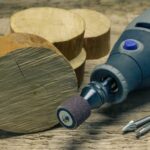Known for its durability and strength, Black Locust is a popular choice among woodworkers. This hardwood, often used in outdoor applications due to its resistance to rot and decay, is highly sought after for its versatility in woodworking projects. Many enthusiasts wonder, “Is Black Locust good for woodworking?” Let’s explore the characteristics, pros and cons, as well as tips for working with this unique wood.
Black Locust wood comes from the Black Locust tree, scientifically known as Robinia pseudoacacia. This tree species is native to North America and Europe, and its wood is renowned for its high density, tight grain pattern, and distinctive golden to light brown color. These qualities make Black Locust wood ideal for various woodworking projects ranging from furniture making to outdoor structures.
When it comes to working with Black Locust wood, there are several factors to consider. Its density can make it challenging to work with hand tools but yields excellent results when using power tools. The tight grain pattern allows for smooth finishes but can also cause tear-out if not properly handled. Additionally, the natural color of Black Locust wood may darken over time when exposed to UV light, adding character to finished pieces.
Characteristics of Black Locust Wood
Black Locust wood, also known as Robinia pseudoacacia, is a highly sought-after material in the world of woodworking. Its popularity stems from its impressive durability, strength, and aesthetic appeal. One of the key characteristics of Black Locust wood is its density, which is comparable to that of oak and hickory. This makes it an excellent choice for projects that require sturdy and long-lasting materials.
In terms of grain pattern, Black Locust wood typically features a straight grain that gives it a smooth and uniform appearance. The color of Black Locust wood varies from light to medium brown with slight hints of yellow or red tones. Over time, the wood may darken slightly, enhancing its natural beauty even further. The combination of its dense nature, straight grain, and warm color make Black Locust a versatile option for various woodworking projects.
When it comes to working with Black Locust wood, there are several pros and cons to consider. On the positive side, this hardwood is known for its resistance to rot, decay, and insect damage due to its high levels of natural oils. It also boasts excellent stability once dried properly.
However, one challenge that woodworkers may face is its hardness, which can make it challenging to work with hand tools. Despite this drawback, many craftsmen find that the benefits outweigh the difficulties when using Black Locust wood in their projects.
Pros and Cons of Working With Black Locust Wood
Black Locust wood, known for its durability and resistance to decay, is a popular choice for woodworking projects. However, like any type of wood, it comes with its own set of pros and cons. Understanding these factors is essential when considering using Black Locust wood for your projects.
Here are some of the pros of working with Black Locust wood:
- Durability: Black Locust wood is incredibly strong and durable, making it ideal for outdoor projects such as decks, fences, and furniture.
- Resistance to decay: Being naturally resistant to rot and decay, Black Locust wood is an excellent choice for structures exposed to the elements.
- Stability: Black Locust wood has minimal expansion and contraction with changes in humidity, making it a reliable option for long-lasting projects.
Despite its many benefits, there are also some cons to consider when working with Black Locust wood:
- Difficult to work with: Due to its density and hardness, Black Locust wood can be challenging to cut and shape with conventional tools.
- Prone to splintering: The grain of Black Locust wood can be prone to splintering, requiring extra care during the woodworking process.
- Cost: While its durability makes it a worthwhile investment, Black Locust wood can be more expensive than other types of lumber.
Comparison With Other Popular Woodworking Woods
Black Locust wood is a popular choice for woodworking projects due to its unique characteristics and qualities. When comparing Black Locust wood with other popular woodworking woods, it stands out in several aspects. One key factor that sets Black Locust apart is its remarkable durability and rot resistance.
This makes it an excellent option for outdoor furniture, decking, and fencing that will be exposed to the elements. In terms of strength, Black Locust is known to be harder than many hardwoods such as oak or maple, making it ideal for projects that require a sturdy and long-lasting material.
Color and Grain
One of the distinguishing features of Black Locust wood is its distinct grain pattern and color. The heartwood of Black Locust ranges from a light golden brown to a darker reddish brown, while the sapwood is typically pale yellow.
The grain of Black Locust wood is usually straight and uniform, adding to its appeal for various woodworking applications. Compared to other woods like cedar or pine, Black Locust offers a unique aesthetic that can enhance the visual appeal of any project.
Workability
While Black Locust is renowned for its durability and strength, it does pose some challenges when it comes to workability. The wood has a high density which can make it difficult to saw or shape using traditional woodworking tools.
Additionally, due to its hardness, Black Locust may require pre-drilling before nailing or screwing to prevent splitting. Despite these challenges, with the right techniques and tools such as carbide-tipped blades and sharp chisels, working with Black Locust can yield stunning results in woodworking projects.
Types of Woodworking Projects Suitable for Black Locust Wood
Black Locust wood is a highly versatile material that can be used for a variety of woodworking projects. Its durability and strength make it ideal for outdoor applications, such as decking, fencing, and even furniture for patios or gardens. The natural resistance of Black Locust to rot and decay makes it a popular choice for exterior projects that will be exposed to the elements.
When it comes to indoor projects, Black Locust wood’s beautiful grain pattern and golden hues make it a stunning choice for furniture pieces like tables, chairs, cabinets, and flooring. Its hardness also makes it suitable for high-traffic areas where durability is essential. Additionally, its stability and resistance to warping make it an excellent option for items that require precise construction, such as musical instruments or cutting boards.
Here are some types of woodworking projects suitable for Black Locust wood:
- Outdoor furniture
- Decking
- Fencing
- Interior flooring
- Cabinetry
- Tables and chairs
Considering the versatility and durability of Black Locust wood, it is clear why it is a popular choice among woodworkers for various projects. Whether you are looking to create a piece of furniture that will last generations or build a sturdy outdoor structure that can withstand the elements, Black Locust is an excellent option that combines beauty and functionality.
Overall, Black Locust wood’s unique characteristics make it well-suited for a wide range of woodworking projects, both indoors and outdoors. Its strength, durability, and attractive appearance set it apart from other woods commonly used in woodworking. By considering the specific qualities of Black Locust wood and choosing the right tools and techniques, woodworkers can create stunning pieces that will stand the test of time.
Tips for Working With Black Locust Wood
Black Locust wood, known for its durability and strength, is a popular choice for woodworking projects. Its dense nature and resistance to decay make it suitable for outdoor applications such as decking, fencing, and furniture. When working with Black Locust wood, there are several tips to keep in mind to ensure a successful project.
When it comes to choosing the right tools for working with Black Locust wood, it is important to use high-quality tools that are sharp and in good condition. Due to the density of the wood, carbide-tipped saw blades and cutting tools are recommended for clean and efficient cuts. Additionally, using drills with sharp bits and properly set up machinery will help prevent tearing and splintering of the wood.
In terms of techniques, it is advisable to pre-drill holes before driving screws or nails into Black Locust wood to avoid splitting. The wood tends to be prone to warping if not properly seasoned, so allowing it to acclimate and dry out before working with it is crucial. It is also recommended to work slowly when cutting or shaping Black Locust wood, as rushing through the process can lead to mistakes or damage to the material.
Lastly, taking precautions when working with Black Locust wood is important for personal safety. The dust from this hardwood can cause skin irritation or respiratory issues if proper protective gear is not used. Wearing a mask, goggles, and gloves while working with Black Locust wood is advised to minimize health risks associated with handling this type of lumber.
Overall, while it requires some extra care and attention compared to softer woods, Black Locust’s remarkable strength and durability make it a rewarding choice for various woodworking projects when approached with the right tools, techniques, and precautions.
Finishing Options for Black Locust Wood Projects
Black Locust wood, known for its durability and strength, is a popular choice for woodworking projects. When it comes to finishing options for Black Locust wood projects, there are several alternatives to consider.
Due to its natural resistance to decay and insects, some woodworkers choose to leave Black Locust unfinished for outdoor projects, allowing it to weather and develop a beautiful silvery-gray patina over time. However, if you prefer a different look or want added protection, there are various finishing options available.
One common finishing option for Black Locust wood is applying a clear outdoor sealant or varnish. This helps protect the wood from UV rays, moisture, and other environmental factors while enhancing the natural color and grain of the wood.
For indoor projects, you can also use a clear polyurethane finish to add a glossy or satin sheen to the surface of the wood. Another popular choice is using an oil finish like teak oil or tung oil, which penetrates the wood fibers to provide long-lasting protection and a smooth feel.
It’s important to note that due to its dense nature, Black Locust wood can be challenging to stain evenly. If you prefer a stained finish, it’s recommended to test the stain on a scrap piece of Black Locust first to ensure satisfactory results. Additionally, when applying any finish to Black Locust wood, make sure to follow the manufacturer’s instructions carefully and allow ample drying time between coats for optimal results.
| Finishing Option | Description |
|---|---|
| Clear Outdoor Sealant/Varnish | Protects against UV rays and moisture while enhancing natural color. |
| Clear Polyurethane Finish | Adds glossy or satin sheen for indoor projects. |
| Oil Finish (Teak Oil/Tung Oil) | Penetrates wood fibers for long-lasting protection with smooth feel. |
Sustainability and Environmental Impact of Using Black Locust Wood
In conclusion, Black Locust wood is a versatile and durable option for woodworking projects. Its high density, strong grain, and beautiful color make it a popular choice among woodworkers. While working with Black Locust wood may present some challenges due to its hardness, the end results are often worth the effort.
When compared to other popular woodworking woods such as oak or maple, Black Locust stands out for its resistance to rot and decay, making it ideal for outdoor projects such as decking or fencing. Its strength also makes it suitable for structural purposes like beams or posts.
Overall, Black Locust wood is a sustainable choice for woodworking as it is a fast-growing species that can be harvested responsibly. Its environmental impact is relatively low compared to exotic hardwoods that may come from deforested areas. By choosing Black Locust wood for your woodworking projects, you are not only creating beautiful pieces but also supporting sustainable practices in the lumber industry.
Frequently Asked Questions
Is Black Locust Wood Good for Woodworking?
Black Locust wood is highly valued in woodworking due to its durability, strength, and resistance to rotting and insects. It is considered an excellent choice for outdoor projects like decking, fencing, and furniture.
What Can Black Locust Wood Be Used For?
Black Locust wood finds use in a variety of applications beyond just woodworking. It is commonly used for firewood because it burns long and hot. Additionally, it can be used for landscaping projects like building retaining walls or constructing garden boxes.
Is Black Locust Sawdust Toxic?
While Black Locust sawdust itself is not toxic, some individuals may experience allergic reactions when exposed to it. It’s always recommended to wear proper protective gear when working with any type of sawdust to prevent respiratory issues or skin irritation from occurring.

Hi everyone! I’m a woodworker and blogger, and this is my woodworking blog. In my blog, I share tips and tricks for woodworkers of all skill levels, as well as project ideas that you can try yourself.





